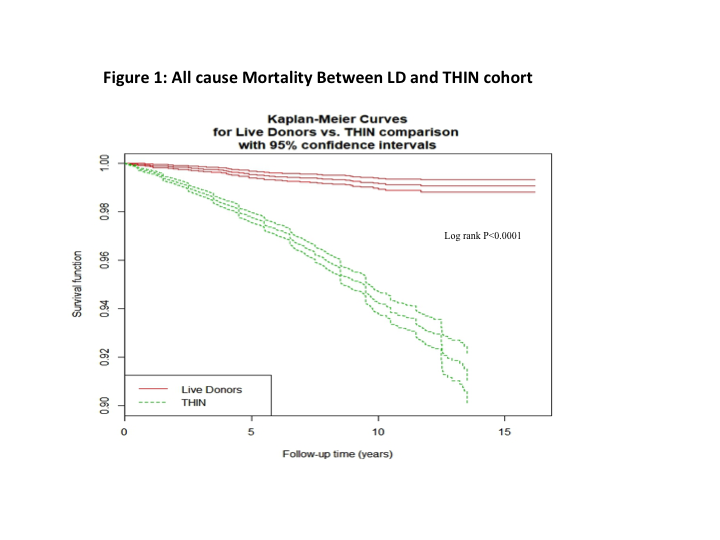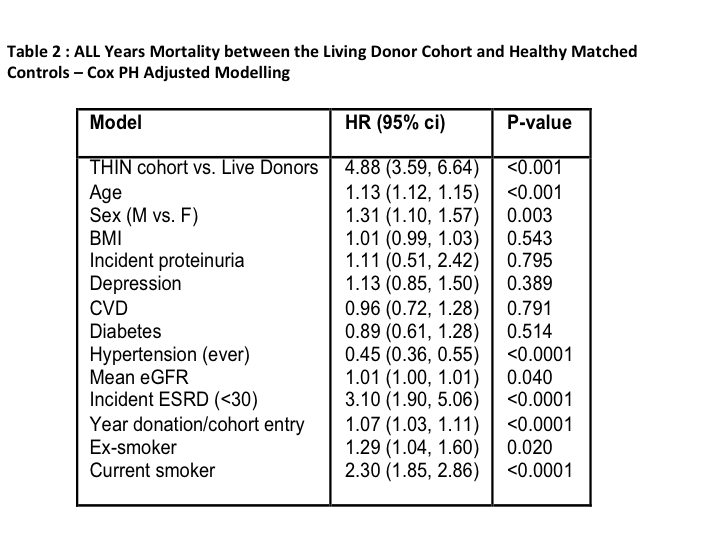Comparative Mortality of Live Kidney Donors in the UK: 15 Year Cohort Study
Nithya Santhana Krishnan1,2, Lisa Mumford3, Graham Lipkin4, Simon Fletcher1, Indranil Dasgupta5, Paramjit Gill6, Ronan Ryan7, Neil Raymond8.
1Renal Unit, University Hospitals Coventry and Warwickshire NHS Trust, Coventry, United Kingdom; 2Faculty of Health and Life Sciences, Coventry University, Coventry, United Kingdom; 3Statistics and Clinical Studies, Organ Donation and Transplant, National Health Services Blood and Transplant, Bristol, United Kingdom; 4Renal Unit, University Hospitals Birmingham, Birmingham, United Kingdom; 5Renal Unit, Birmingham Heartlands Hospital, Birmingham, United Kingdom; 6Unit of Academic Primary Care, University of Warwick, Coventry, United Kingdom; 7Primary Care, Primary Care, West Midlands, Birmingham, United Kingdom; 8Statistics, University Hospitals Coventry & Warwickshire NHS Trust, Coventry, United Kingdom
Aim: To investigate the all-cause mortality experience of U.K live kidney donors in comparison with healthy non-donor controls with up to 15 years follow-up.
Methods: Ethics approval was already in place to accrue data from datatbase. Study protocol was reviewed and passed by Renal Registry projects advisory group, and an independent scientific review committee, before release of the data.
Cohorts for Study: A) Live Donors (LD) dataset: Dataset obtained from UK Transplant Registry held by National Health Service Blood and Transplant, U.K. All live kidney donors from January 1st 2001 to 31st December, 2013 included and the end date was 31st December 2016 B) Comparative Cohort, The Health Improvement Network (THIN) database : This is a large UK general practice database which contains anonymized longitudinal patient records from over 500 practices. Data from THIN was collected stratified by age, gender and year of entry to provide a large comparator cohort, excluding a number of baseline conditions that would have been a contraindication to donation.
Results: Table 1 shows baseline characteristics of LD and THIN.

Figure 1 shows a significant difference in mortality between the LD and the THIN cohort, with the LD group doing better.


Table 2 showing Cox Proportional hazard Modelling shows that the hazard ratio was significantly more for the THIN group even after adjustments for confounding variables. Further analyses were conducted to examine mortality for different age bands. This showed that there was no difference in 18-29 years age group, but statistically significant differences emerged with longer durations of follow-up in the other age groups; 30-44 years (P= 0.01), 45-59 years (P<0.001) and >60 years (P<0.001).
Conclusions: There was no increased risk of mortality in the LD group compared to a healthy cohort on analysis of a 15-year UK database.
Warwickshire private Hospitals Charity Grant. Coventry Kidney Research fund, U.K.
